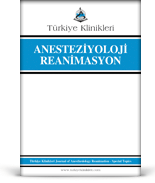Amaç: Kliniğinde, ekokardiyografi olan anesteziyoloji ve reanimasyon, acil tıp ve yoğun bakım uzmanlarının ekokardiyografiyi kullanımı, eğitime ihtiyaç duyup duymadıkları ve hasta izlemindeki farklılıkları konusunda bakış açısını değerlendirmektir. Gereç ve Yöntemler: Çalışma için yerel etik kurul onayı alındı. İki yüz elli (100 anesteziyoloji ve reanimasyon, 100 acil, 50 yoğun bakım uzmanı) katılımcıya, yüz yüze ve e-posta aracılığıyla ulaşıldı. Anket soruları yöneltilip, kaydedildi. Beş soru demografik verilere yönelik, 6 soru 5'li Likert türü, 4 soru neden-sonuç ve 5 soru evet-hayır şeklindeydi. Bulgular: Kliniğinde, ekokardiyografi olduğu hâlde acil uzmanları, ekokardiyografiyi diğer 2 kliniğe göre daha fazla kullanmaktadır. Tüm katılımcılar, ekokardiyografi konusunda ek eğitime ihtiyaç duyduklarını belirtmişlerdir. Acil ve yoğun bakım uzmanları, volüm takibinde ekokardiyografiyi anestezistlere göre daha fazla kullanmaktadır. Anestezistler, akut travmalı hastaların %70'inde ekokardiyografi kullanılmalı derken; acil ve yoğun bakım uzmanları, akut travma ile gelen her hastada ekokardiyografi yapılmalı diye ifade etmişlerdir. Katılımcıların tamamı, kardiyovasküler hastalığı ve yoğun bakıma ihtiyacı olan hastalarda ekokardiyografi kullanılması gerekliliğini bildirmişlerdir. Anestezistler, operasyona girecek hastaların %30'unda, acil uzmanları acile başvuran hastaların %50'sinde, yoğun bakım uzmanları yoğun bakımda takip edilen hastaların tamamında ekokardiyografiye ihtiyaç duymaktadır. Sonuç: Günümüzde ekokardiyografi, hastanın gerçek zamanlı değerlendirilmesinde önemli bir tanı ve tedaviyi yönlendirme aracı olmuştur. Anesteziyoloji, acil tıp ve yoğun bakım uzmanlarının, ekokardiyografi konusunda eğitimi ve yeterlilikleri hasta güvenliğini artıracaktır.
Anahtar Kelimeler: Ekokardiyografi; sağlık anketi; anestezi
Objective: This study aims to evaluate the point of view of anesthesiology and reanimation, emergency, and intensive care unit specialists' use of echocardiography, whether they need education, and their differences in patient follow up. Material and Methods: The local ethics committee approved the study. Two hundred fifty (100 anesthesiology and reanimation, 100 emergency, 50 intensive care unit specialists) participants were interviewed face to face and via e-mail. Questionnaire questions were asked, and answers were recorded. Fivequestions were demographic data, six-question Likert types, four questions were cause-effect, and five-questions were yes-no. Results: Although clinics have echocardiography, emergency specialists use echocardiography more than two clinics. All participants stated that they needed additional training on echocardiography. Emergency medicine and intensive care unit specialists use echocardiography more than anesthetists in volume follow-up. Anesthesiologists stated that 70% of patients with acute trauma should use echocardiography, while emergency and intensive care specialists stated that echocardiography should be done in every patient with acute trauma. All of the participants reported the necessity of using echocardiography in patients who need cardiovascular disease and intensive care. Anesthesiologists need echocardiography in 30% of patients to be operated, 50% of emergency patients who apply to the emergency department, and intensive care specialists in all patients who are followed in intensive care. Conclusion: Today, echocardiography has become an essential diagnostic and treatment tool for real-time evaluation of the patient. Training and competencies of anesthesiology, emergency, and intensive care professionals on echocardiography will increase patient safety.
Keywords: Echocardiography; health survey; anesthesia
- Eşkin MB, Coşar A. [Use of echocardiography in the intensive care unit]. J Turk Soc Intens Care. 2012;10:28-36.
- Kneeshaw JD. Transoesophageal echocardiography (TOE) in the operating room. Br J Anaesth. 2006;97(1):77-84. [Crossref] [PubMed]
- Balzer F, Trauzeddel RF, Ertmer M, Erb J, Heringlake M, Groesdonk HV, et al. Utilization of echocardiography in intensive care units: results of an online survey in Germany. Minerva Anestesiol. 2019;85(3):263-70. [Crossref] [PubMed]
- Cheitlin MD, Armstrong WF, Aurigemma GP, Beller GA, Bierman FZ, Davis JL, et al; American College of Cardiology; American Heart Association; American Society of Echocardiography. ACC/AHA/ASE 2003 guideline update for the clinical application of echocardiography: summary article: a report of the American College of Cardiology/American Heart Association Task Force on Practice Guidelines (ACC/AHA/ASE Committee to Update the 1997 Guidelines for the Clinical Application of Echocardiography). Circulation. 2003;108(9):1146-62. [Crossref] [PubMed]
- Montoya J, Stawicki SP, Evans DC, Bahner DP, Sparks S, Sharpe RP, et al. From FAST to E-FAST: an overview of the evolution of ultrasound-based traumatic injury assessment. Eur J Trauma Emerg Surg. 2016;42(2):119-26. [Crossref] [PubMed]
- Ursprung E, Oren-Grinberg A. Point-of-care ultrasound in the perioperative period. Int Anesthesiol Clin. 2016;54(1):1-21. [Crossref] [PubMed]
- Frankel HL, Kirkpatrick AW, Elbarbary M, Blaivas M, Desai H, Evans D, et al. Guidelines for the appropriate use of bedside general and cardiac ultrasonography in the evaluation of critically ill patients-part I: general ultrasonography. Crit Care Med. 2015;43(11):2479-502. [Crossref] [PubMed]
- Tıpta Uzmanlık Kurulu. 23/06/2010 tarih ve 82 sayılı Karar. Sayfa 1/20.
- Salkind NJ. Technique for the measurement of attitudes, a. Encyclopedia of Research Design. Vol. 1. Thousand Oaks, CA: SAGE Publications, Inc.; 2010. p.1571-492.
- Jozwiak M, Monnet X, Teboul JL. Less or more hemodynamic monitoring in critically ill patients. Curr Opin Crit Care. 2018;24(4):309-15. [Crossref] [PubMed]
- Soriano BD, Fleishman CE, Van Hoever AM, Wright B, Printz B, Tacy TA, et al. Determinants of physician, sonographer, and laboratory productivity: analysis of the third survey from the American Society of Echocardiography Committee on Pediatric Echocardiography Laboratory Productivity. J Am Soc Echocardiogr. 2018;31(9):976-82. [Crossref] [PubMed]
- The Association of Anaesthetists of Great Britain & Ireland, The Royal College of Anaesthetists, The Intensive Care Society. Ultrasound in anaesthesia and intensive care: a guide to training. 2011. https://anaesthetists.org/Portals/0/PDFs/Guidelines%20PDFs/Guideline_ultrasound_anaesthesia_intensive_care_guide_training_2011_final.pdf?ver=2018-07-11-163758-490&ver=2018-07-11-163758-490
- Neskovic AN, Edvardsen T, Galderisi M, Garbi M, Gullace G, Jurcut R, et al. Focus cardiac ultrasound: the European Association of Cardiovascular Imaging viewpoint. Eur Heart J Cardiovasc Imaging. 2014;15(9):956-60. [Crossref] [PubMed]
- Neskovic AN, Hagendorff A, Lancellotti P, Guarracino F, Varga A, Cosyns B, et al; European Association of Cardiovascular Imaging. Emergency echocardiography: the European Association of Cardiovascular Imaging recommendations. Eur Heart J Cardiovasc Imaging. 2013;14(1):1-11. [Crossref] [PubMed]
- Jozwiak M, Mercado P, Teboul JL, Benmalek A, Gimenez J, Dépret F, et al. What is the lowest change in cardiac output that transthoracic echocardiography can detect? Crit Care. 2019;23(1):116. [Crossref] [PubMed] [PMC]
- Leichtle SW, Singleton A, Singh M, Griffee MJ, Tobin JM. Transesophageal echocardiography in the evaluation of the trauma patient: a trauma resuscitation transesophageal echocardiography exam. J Crit Care. 2017;40:202-6. [Crossref] [PubMed]







.: İşlem Listesi